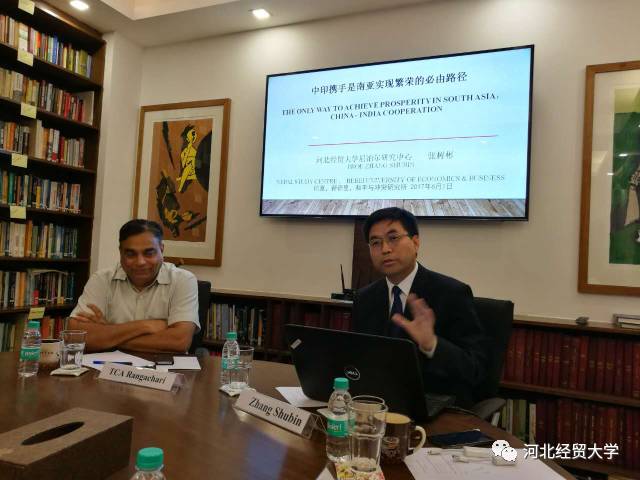
2017年6月1日,河北经贸大学尼泊尔研究中心主任张树彬应邀在印度首都新德里出席由印度智库和平与冲突研究所主办的中尼印三边会议,作了题为《中印携手是南亚实现繁荣的必由路径》(China - India Cooperation is the Only Way to Achieve Prosperity in South Asia)的主旨发言。新华社以《中国学者呼吁建立中尼印三国经济文化走廊》为题刊发消息。
附:印度新德里智库平与冲突研究所网站刊发的张树彬发言摘要
IPCS DISCUSSION
India-China-Nepal Trilateralism
Report
IPCS report on ‘India-China-Nepal Trilateralism’, a round-table held on 1 June 2017.
Only Way to Achieve Prosperity in South Asia: China-India Cooperation
Zhang Shubin
Professor and Director,Nepal Study Centre,Hebei University of Economics and Business
China’s OBOR initiative includes the Silk-Road Economic Belt and a 21st Century Maritime Silk Road (MSR). It is based on three communities: of responsibility, shared interests, and destiny. The project is based on cooperation priorities such as policy coordination, facilities connectivity, unimpeded trade, financial integration and people-to-people bonds. Peace and cooperation and mutual learning and benefit are the founding ideals of the project.
The Nepal rail project is expected to be completed by 2020. In the recently announced budget, a provision of 400 million Nepali Rupees was made by the Nepalese government for the project. This is however an insufficient amount. Connectivity is a foundation of the OBOR project and is vital for the various countries to ultimately benefit from it. It is all the more important for Nepal if it intends to benefit from the OBOR initiative. Therefore, it is essential for the country to pay more attention to its rail and road links connectivity. It came as a surprise to China that the critically important China-Nepal railway project found no mention in the Kathmandu investment summit, held earlier in 2017.
China and India are the two most important member countries of the AIIB. To facilitate greater cooperation between the two, it is important to develop people-to-people communications.
The OBOR initiative is a conglomeration of various economic corridors which include the Eurasian land bridge, the China-Mongolia-Russia economic corridor, the Indo-China Peninsula economic corridor, the CPEC, the BCIM and the China-Central Asia-West Asia economic corridor. The China-Nepal-India economic and cultural corridor will add greater significance to the initiative. Buddhism forms an important cultural link between the three countries. There are approximately one hundred million Buddhists in China. Given that some of the most religiously significant sites lie in Nepal and India, an annual visit of Chinese pilgrims to these places will significantly contribute in building people-to-people contact.
The proposal for China-India-Nepal trilateralism came much before OBOR. Nepal and China signed the transit transport treaty in 2016. The OBOR initiative will be undertaken in three forms in Nepal; through China-Nepal bilateral cooperation, the BCIM project and the China-Nepal-India trilateralism initiative.
Xi Jinping talked about shared future for mankind and the OBOR initiative is a step in this direction. However for the initiative to successfully take off in South Asia, it is important for the countries to get abandon the zero-sum game mindset. Nepal should not be seen as India’s backyard and efforts should be made in developing it into South Asia’s Brussels.